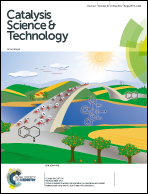Molecular p–n heterojunction-enhanced visible-light hydrogen evolution over a N-doped TiO2 photocatalyst†
Abstract
This study was mainly aimed at designing molecular p–n heterojunctions on the surface of N-doped TiO2 for visible-light hydrogen evolution. A series of NiO/N-TiO2 samples were prepared via NH3-postnitridation of nickel oxide-modified TiO2. H2 production from ethanol/water solution was utilized as a model reaction to evaluate the photocatalytic properties of the catalysts. Compared to N-TiO2, a 90-fold-enhanced H2 evolution rate was achieved over the optimal NiO/N-TiO2 catalyst with a 0.5 wt% Ni content. Detailed characterizations clearly showed that loading NiO via wet impregnation leads to high dispersion of Ni2+ species on the surface oxygen vacancy (Vo) sites of the anatase TiO2 nanoparticles, predominantly presenting mononuclear Ti–O–Ni heteroatomic clusters on the surface of TiO2 in the case of low Ni content. These surface heteroatomic clusters can speed up the transfer and separation of photogenerated carriers of N-TiO2. It can thus be established that the molecular Ti–O–Ni heterojunctions are the main contributors to the synergistic enhancement of H2 evolution, whereas NiO nanoclusters are not responsible for the photoactivity. Only one of the N species, N–Ti–Vo, was active and effective for this cooperation with the hydrogen-releasing Ni sites, which can induce ca. 20-fold improvement of hydrogen production over NiO/TiO2 under visible light irradiation.



 Please wait while we load your content...
Please wait while we load your content...